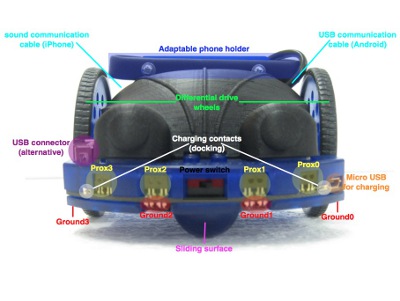Wheelphone technical specifications: Difference between revisions
Jump to navigation
Jump to search
(Created page with "[{{fullurl:Wheelphone}} Wheelphone main wiki]<br/> =Hardware= The following figure shows the main components of the Wheelphone robot and where they are physically placed:<br/>...") |
No edit summary |
||
| Line 2: | Line 2: | ||
=Hardware= | =Hardware= | ||
The following figure shows the main components of the Wheelphone robot and where they are physically placed:<br/> | The following figure shows the main components of the Wheelphone robot and where they are physically placed:<br/> | ||
[ | [https://www.gctronic.com/doc/images/wheelphone-schema.jpg <img width=400 src="https://www.gctronic.com/doc/images/wheelphone-schema-small.jpg">] | ||
=Detailed features= | =Detailed features= | ||
Latest revision as of 12:35, 27 January 2023
1 Hardware
The following figure shows the main components of the Wheelphone robot and where they are physically placed:

2 Detailed features
| Feature | Technical information |
| Size, weight | 92 mm width, 102 mm length, 68 mm height, 200 g |
| Battery, autonomy | LiPo rechargeable battery (1600 mAh, 3.7 V). About 3.5 hours autonomy (motors running at middle speed continuously). Recharging time about 1h45 |
| 2 options to charge | with a micro USB female connector in front of the robot, 500mA with 2 golden contacts in front and the relative docking station, 1000mA |
| Processor | Microchip PIC24FJ64GB004 @ 16MHz (8 MIPS); 16 bit microcontroller ... and the one of the phone |
| Memory | RAM: 8 KB; Flash: 64 KB ... and the one of the phone |
| Motors | 2 DC motors with gear; speed controlled (forward direction) with backEMF |
| Speed | Max: 30 cm/s |
| Mechanical structure | Molded plastic case, adaptable phone holder |
| IR sensors | 4 infra-red sensors measuring ambient light and proximity of objects up to 6 cm (placed on the front-side of the robot) 4 ground sensors detecting cliffs or color differences (placed on the bottom-front-side of the robot) |
| LEDs | 1 red/green LED (charging/charged indicator) |
| Communication | Android: USB high speed; iPhone: sound cable. Both reaches 20 Hz sensor refresh |
| Additional connectors | 1 USB connector (type A) as alternative to the micro USB cable |
| Programming | Android SDK, iOS SDK |